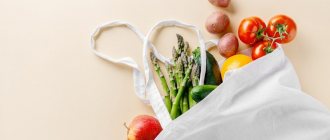Carbohydrates are unfairly blamed for all the troubles of people who are trying to lose weight. The problem is that today you can read about the dangers of almost any product and drown in a sea of false information without ever getting to the bottom of it. But you can't fool science. There is no evidence that carbohydrates are harmful for weight loss. In this article I will tell you whether you should be afraid of carbohydrates or whether you need to make friends with them, how they affect weight loss, how many carbohydrates you should consume and from what products. You'll understand what a healthy weight loss approach looks like and dispel a few nutrition myths in your head.
What are carbohydrates in food
Carbohydrates are macronutrients in food, just like proteins and fats.
The breakdown product of carbohydrates in our body is monosaccharides (glucose, fructose and others). Or rather, even so - any carbohydrate from food will break down in our body to glucose, fructose and other simple carbohydrates included in its composition - like sugar, like whole grain bread, and the oxidation of 1 g of carbohydrates will release 4 kcal of energy (but more on that later). The body doesn't care where we got this or that carbohydrate from.
Table 1. Classification of carbohydrates
| Monosaccharides | Disaccharides | Polysaccharides |
| Glucose and fructose | Sucrose, maltose, lactose | Starch, fiber, cellulose, chitin, glycogen |
| They consist of one molecule, so they are quickly absorbed. | They consist of two molecules of monosaccharides and require a longer time to digest and assimilate compared to monosaccharides. | They consist of tens, hundreds, thousands of monosaccharides. They take a long time to digest and absorb, unlike simple carbohydrates. Contains many nutrients (proteins, vitamins and minerals). |
This is the most accessible source of energy from food for our body. That is, it is easier for the body to use energy from carbohydrates than from fats and proteins. However, this does not mean that the body does not burn fats and proteins for its needs, it is just that carbohydrates are used first when performing any work.
Carbohydrates in our body are stored as glycogen in the muscles and liver. Glycogen in muscles (it contains 1-3% of the total weight of muscles) ensures their motor activity, liver glycogen (its content is approximately 100-120 g) serves to maintain the functioning of body systems. In total, approximately 350-500 g of glycogen can be accumulated in the body of an adult, or, if converted into calories, 1400-2000 kcal, which the body uses to support itself and perform physical work - breathing, maintaining normal blood sugar levels, brain function, walking , hand movements, doing exercises, etc.
Each gram of glycogen in the muscles holds an additional 3-4 g of water. When glycogen stores are replenished, muscles appear full. This also explains the quick results of low-carb diets. By severely limiting your carbohydrate intake, you actually get rid of water, reducing your weight significantly. However, the body will still equalize the water content in the body and the weight may even increase compared to the original if you do not maintain a calorie deficit. Read about the effect of water balance on body weight and what calorie deficit is needed to lose weight.
What are fast carbohydrates
It should be noted that during the digestion process, proteins, fats and carbohydrates break down into simpler components. If we talk about easily digestible carbohydrates, their structure is represented by one or two molecules. This explains the properties of rapid absorption by the body. Characteristic features:
- sweet taste;
- good dissolution in water.
Compared to complex components (fiber, starch), simple compounds are converted in a few minutes and enter the blood, which causes a surge in insulin. This indicates a high glycemic index of the product. If the energy received is not used, the excess will go to fat depots.
Chemical composition
Simple carbohydrates are made up of one or two molecules of simple sugars:
Monosaccharides are simple sugars, of which there are over 200 varieties, but the main ones are familiar to almost everyone:
- Glucose is a naturally occurring sugar that is found in food products. It is also called sugar or dextrose and is found in the blood. Included in most sports supplements - gainers, specialized drinks, creatine with a transport system. It is one of the main ingredients in carbonated drinks, desserts, preserves, etc.
- Galactose is produced by the mammary glands of mammals and is found in milk.
- Fructose is the only one of all that has no effect on the replenishment of glycogen reserves in the muscles. By and large it is not used by human cells (with the exception of sperm). Therefore, the liver takes on the complex function of processing it into glucose, partially converting it into glycogen.
Disaccharides include two monosaccharide molecules:
- Sucrose is also known as table sugar. Includes one molecule each of glucose and fructose. Promotes damage to tooth enamel and leads to the formation of caries.
- Lactose is the main element of dairy products and milk, consisting of one molecule of glucose and galactose. Residents of Africa and Asia lack its enzymes, which does not allow this type of sugar to be absorbed.
- Maltose - consists of two glucose molecules, also called maltose sugar. Contained in cereals and sprouted seeds, as well as in beer products.
Another name for simple carbohydrates is fast, because their molecular compounds are short. This promotes rapid breakdown into glucose, which, in turn, immediately enters the blood, causing a surge in insulin, and it immediately lowers it back. The result is a fairly quick return of the feeling of hunger, despite the recent meal.
The table shows types of simple compounds with specific examples of products.
| Monosaccharides | Disaccharides |
Glucose:
| Sucrose:
|
Fructose:
| Lactose:
|
Galactose:
| Maltose:
|
Are carbohydrates good or bad for weight loss?
Carbohydrates are neither good nor bad for weight loss. To be healthy, you must have them on a diet. What is important for losing weight is a calorie deficit. If you get less energy from food than your body spends per day, you will lose weight. Read a detailed article about energy balance, where I talk about how this principle works in life.
There is no need to exclude carbohydrates from your diet; you need to monitor the caloric content of your diet (read how to count calories correctly).
It is generally dangerous to cut carbohydrates to zero in the long term, since they, in addition to energy, have protective, regulatory and construction functions.
What are carbohydrates
If proteins are the building blocks for muscle tissue, and fats are needed for blood vessels and the heart, then carbohydrates are a source of energy, without which the body’s vital functions are impossible. Their complete exclusion, as you might guess, leads to the fact that a person becomes lethargic, experiences weakness, cannot concentrate on basic tasks, and feels hungry. Doctors say that a deficiency of this macronutrient in the diet (as happens during active weight loss) is the main reason for the craving for “harmful” foods (chocolate, cookies), since they contain glucose, an alternative source of energy.
Figuring out what carbohydrates you can eat while losing weight is the main task of every person who cares about their health. A simple classification helps with this, according to which they are divided into:
- complex or slow;
- simple or fast.
How many carbohydrates do women and men need per day when losing weight?
The amount of required carbohydrates on a diet for men and women is calculated on a residual basis. First of all, proteins are calculated, then fats, then carbohydrates. The order is:
- We determine the amount of protein on a diet from this article.
- We give 30-35% of the caloric content of the diet to fats, but not less than 1 g per 1 kg of current weight for girls.
- All remaining calories will be covered by carbohydrates.
Let's use examples. A woman weighing 75 kg wants to lose weight to 65 kg and found out that to do this she needs to consume no more than 1600 kcal (how to determine how many calories you need to consume per day to lose weight). She also found that she needed 1.8 grams of protein. We multiply 1.8 by the desired weight (I wrote here why you need to calculate protein by the desired weight):
1.8 x 65 = 117 g of protein or 117 x 4 = 468 calories from protein, where 4 is the calorie content of 1 g of protein.
Next we count fats:
1600 x 0.35 = 560 kcal or 560/9 = 62 g of fat, where 9 is the calorie content of 1 g of fat.
But it’s better for girls not to go below the level of 1 g of fat per 1 kg of weight, so we take 75 g of fat or 675 calories as the norm.
And finally, we count carbohydrates using the residual principle:
1600 – 468 – 675 = 457 kcal or 457/4 = 114 g of carbohydrates, where 4 is the calorie content of 1 g of carbohydrates.
100 g of carbohydrates is the minimum amount , or rather 100 g of glucose is needed by the brain daily for normal functioning [1]. Therefore, do not go below this figure.
This plan is a healthy approach to dieting that will allow you to lose weight, maintain muscle, and feel good throughout your weight loss journey. Read how to calculate the duration of a diet.
Norm of carbohydrates per day
The daily amount of this element is never reset to zero, even if you are aimed at rapid weight loss. Completely eliminating carbohydrates means starting the active burning of glycogen, but at the same time giving impetus to disturbances in the functioning of the nervous system, liver, kidneys, heart and other systems. In addition, excess protein, which is typical for weight loss methods of this type, leads to ketoacidosis - poisoning of the body with elements of its breakdown. If you calculate your individual carbohydrate intake per day, you can lose weight without such dire consequences and without feeling constant hunger.
- Printing MTS calls - how to do it. How to get details of MTS calls in your personal account or via SMS
- Acne mash: recipes
- How to make hair thicker and longer, masks and care products. Thick hair at home, photos and videos
When dieting
There is a classic rule that is relevant even for those who want to lose weight quickly - the proportion of carbohydrates in a diet should not be less than half of the daily plate. The ideal ratio is 7:3, where the smaller number refers to the sum of fats and proteins. A shortage is fraught with a permanent feeling of year, as a result of which it will be difficult to maintain the diet. At the same time, simple carbohydrate foods are completely excluded during weight loss, and the indicated figure will need to be supplemented only by those that the body will absorb for a long time.
When losing weight
Even if you need to quickly lose weight, you can only reduce the daily amount of carbohydrates in your diet to 50 g. An individual calculation is more reasonable, according to which at least 2.5 grams of this macronutrient are taken for every kilogram of body weight. So for a woman weighing 55 kg, the daily carbohydrate intake for weight loss will be 137.5-140 g. If there is physical activity, the consumption of this microelement per day increases to 5 g/kg.
Carbohydrate-rich foods
Well, now let's move on to the sources of carbohydrates in food. We decided that carbohydrates are necessary and important for weight loss due to the vitamins, minerals and fiber they contain.
List of foods containing complex/slow carbohydrates
- Fruits (apples, apricots);
- Vegetables (tomatoes, cucumbers, greens, broccoli, cabbage, peppers);
- Nuts and seeds (sunflower and pumpkin);
- Cereals.
Be careful with nuts - they contain a lot of fat and are very high in calories.
About grains separately, since this is a large group of products:
- Cereals (wheat, barley, rye, rice, oats, corn, spelt) and cereal products (flour and flour products, cereals, bulgur and others);
- Buckwheat;
- Quinoa;
- Legumes (peas, beans, soybeans, lentils).
Among grains there are products with different glycemic index:
Everything below 40 units is slow carbohydrates, everything above is fast
Slow carbohydrates in legumes:
| The product's name | Glycemic index | Carbohydrate content in grams per 100 g |
| Beans | 40 | 8,1 |
| Lentils | 25-41 | 20 |
| Dry green peas | 25 | 13 |
| Beans | 15-27 | 4,4 |
Slow carbohydrates in seeds and nuts:
| The product's name | Glycemic index | Carbohydrate content in grams per 100 g |
| Almond | 15 | 11 |
| Walnuts | 15 | 12 |
| Cashews, hazelnuts, peanuts | 15 | 15 |
| Sunflower seeds | 8 | 3,4 |
List of foods containing simple/fast carbohydrates
- Various types of sugar - table, cane, brown and others;
- Syrups, jam, honey, marmalade;
- Starchy vegetables - zucchini, potatoes, beets, carrots, pumpkin;
- Nuts such as peanuts and chestnuts;
- Sweet fruits and berries - grapes, raisins, figs, dates, apricots, prunes, persimmons, bananas, watermelon;
- Pastries and sweets, chocolate.
To enlarge, click on the image.
There are also dairy products. They do not contain many carbohydrates, mostly fast ones, but they are valuable for their high protein content (by the way, I wrote about protein products in this article):
List of foods containing fiber
I will provide an infographic here. But in general, if you have a varied diet, daily servings of vegetables and fruits, and you don't avoid any foods, then you don't have to worry about not having enough fiber.
Healthy carbohydrates: list of foods for weight loss
Carbohydrates are a type of organic substance that our body needs every day, along with proteins and fats.
What types of carbohydrates are there?
All carbohydrates can be divided into three large groups. Let's look at them:
- Simple carbohydrates are carbohydrates based on glucose, fructose, lactose or sucrose. Products containing simple carbohydrates are most often treated with particular caution - after all, these are pastries, cakes, sweet soda, milk chocolate, honey, chips. It is products from this subgroup that most often become the culprits of extra folds at the waist. However, do not forget that fruits and berries are also rich in simple (or fast) carbohydrates, with which the body receives vitamins and beneficial biologically active substances, so you should not completely exclude simple carbohydrates from your diet. Nutritionists recommend including simple carbohydrates (preferably in the form of berries and fruits) in your daily calorie intake and consuming them, if possible, in the first half of the day.
- The next group is complex digestible carbohydrates. These are carbohydrates that basically contain starch. Starch accounts for the majority of the carbohydrates a person consumes daily. Starch is found in grains (bread, flour, cereals) and legumes, as well as potatoes. This subgroup of nutrients is very important for humans, since it is complex digestible carbohydrates, for example, cereals and whole grain bread, that provide us with the main energy during the day. You can feel this yourself: after having breakfast with porridge with berries, you will feel slightly hungry only towards lunch, while after sweet tea with cookies, you will want to eat within an hour.
- And another important group is complex indigestible carbohydrates. The products from this subgroup are based on fiber and cellulose. Such carbohydrates are found in vegetables, fruits and greens. Indigestible carbohydrates are called so because our digestive system is not able to digest and assimilate them. But despite this, they are very important for the body, since they are sources of dietary fiber that nourish the normal intestinal microflora. Foods rich in fiber normalize the functioning of the gastrointestinal tract and provide good immunity in general. In this group of carbohydrates, you should give preference to greens and vegetables, preferably fresh and not thermally processed ones, as well as non-sweet fruits. Between juice and whole fruit, choose the latter - the fruit contains more fiber and less sugar.
How are carbohydrates digested?
Essentially, your body converts any carbohydrate you eat into glucose. However, complex carbohydrates take longer to be absorbed by the body - for this reason, they are sometimes called “slow” carbohydrates. When complex carbohydrate molecules are broken down, there is no sudden release of glucose into the blood; it is released gradually, satisfying a person’s energy needs for several hours.
In order for carbohydrates to be friends and not enemies in your diet, you need to know and pay attention to such a value as the glycemic index of the product. The glycemic index shows how quickly the body absorbs a particular product that is a source of carbohydrates. The higher the glycemic index, the greater the jump in blood glucose levels caused by eating it. For example, sweet yeast baked goods, milk chocolate, and French fries have a high glycemic index. Eating these products is harmful not only to your figure, but also to your health in general, because it can provoke the development of serious diseases (for example, type 2 diabetes). Nutritionists advise paying attention to the glycemic index of the foods you include in your diet. When creating your daily menu, try to ensure that it contains foods with a glycemic index of no higher than 50.
How many carbohydrates do you need per day?
Carbohydrates are an important source of energy for our body, since it is glucose that fuels the brain. For this reason, you cannot create a significant carbohydrate deficit in your diet even if you want to lose a few extra pounds. But do not forget about the norm of carbohydrate consumption. In the most general case, for young women with a moderately active lifestyle who do not have the goal of losing weight, the rate of consumption of these nutrients is calculated using the formula 4-5 g of carbohydrates per 1 kg of weight per day. Try to ensure that a significant portion of your daily carbohydrate intake comes from complex digestible carbohydrates.
What foods to look for healthy carbohydrates in.
Nutrition experts recommend including the following types of carbohydrates in your diet daily:
- - cereals. Unpolished rice and buckwheat are especially useful. Don't limit yourself to the usual types of cereals, try new flavors - for example, bulgur, quinoa.
- - legumes: chickpeas, lentils, beans, peas.
- — vegetables and herbs are an irreplaceable source of fiber. Just be careful with potatoes and beets, as these vegetables have a fairly high glycemic index.
- - fruits and berries. These foods contain vitamins and minerals necessary for the body that cannot be obtained from other foods. However, do not forget that fruits and berries are sources of simple carbohydrates, so it is better to limit their amount to 400-500 grams per day and consume them in the first half of the day, before 16-17 hours.
All of the above products can and should be included in your diet, even if your goal is weight loss. However, do not forget about calorie standards - if you exceed the amount of even healthy carbohydrates in your diet, weight gain is inevitable.
It is better to limit the following products in the diet, and if the goal is to lose weight, even transfer them to the “black list”:
- Sugar. Try to develop the habit of drinking unsweetened drinks. But at the initial stage, when you find it difficult to come to terms with life without a sweet taste, use natural, safe sweeteners, such as stevia.
- Sugar containing products. Cakes, sauces, preserves and jams, confectionery, sweet carbonated drinks - manufacturers add a significant amount of sugar to these products, which many people needlessly do not take into account when counting calories.
- Bakery products made from premium flour are a source of fast carbohydrates; it is better to replace them with pasta made from wholemeal flour and whole grain yeast-free bread.
- Breakfast cereals and instant cereals (from bags) do not contain healthy complex carbohydrates, but they contain a lot of sugar.
Products from this list should be limited not only to those who are losing weight, but also to people who adhere to a healthy diet, since their excess in the diet can provoke various diseases. In accordance with WHO recommendations from 2015, sugar and sugar-containing products (cookies, gummies, etc.) are recommended to be limited to 4-5% of the total daily intake of carbohydrates. For example, this is about 4-5 teaspoons of sugar per day for a young woman with an average weight of 60 kg who is not trying to lose weight.
Do not forget that if you adhere to proper nutrition, regardless of whether your goal is to lose weight or you want to maintain your current shape, you need to include foods containing healthy carbohydrates in your diet every day. Give preference to the “right” carbohydrates, pay attention to the glycemic index of the foods you eat, and do not forget that if you eat harmoniously and nutritiously, not forgetting a sense of proportion, you can keep your body in great shape without the help of diets.
Example of a list of carbohydrate foods for weight loss for a week
Regarding ready-made menus for the week, I will not give standard solutions here, because they cannot exist. Someone eats 2-4 times a day, someone can eat often 5-6 times a day, but eat little by little and feel good. People with different abilities and with different characteristics of the body (weight, age, lifestyle and activities, presence of diseases or disorders) cannot and should not eat the same. If you get rid of the idea that there are harmful or healthy carbohydrates, you will understand that you can eat everything if it fits into your caloric intake.
An example of a typical menu for a week of “proper nutrition”. There is nothing wrong with it, except that it does not take into account the characteristics of your body, your caloric intake and your ability to eat 5 times a day
What carbohydrates should you exclude when losing weight - list of products
If you do not count calories, but determine your diet by eye, then it makes sense to limit yourself in consuming carbohydrate foods with a high glycemic index and high calorie content. Such foods do not satiate well, have a small volume, the feeling of hunger comes quickly after them (here I tell you how to get rid of the feeling of hunger during a diet), the risk of going over calories in a day is increased:
- Honey.
- Bakery products.
- Cheap pasta.
- Canned fruits.
- Pastries, cakes, cookies, sugar, candies.
- Ice cream.
- Crackers, chips.
It’s not these foods themselves that are scary, but the high amount of calories in them, and even then, if you don’t control them.
Low-calorie recipes will be a real find for food lovers. There are really a lot of them, here is an example of VKontakte groups where such recipes are published - https://vk.com/food_and_diet, https://vk.com/dietsrecipes.
Even if you eat only PP recipes (PP - proper nutrition), but in excess of calories, you will still gain excess weight. Therefore, the easiest way to learn to control your diet is to count calories.
After two to three months of calculations, you will become a professional in estimating the calorie content of your diet and can give up counting calories, determining how much you need to eat by eye and tracking the results on the scale, by girth and reducing the percentage of fat (read about 10 ways to measure the percentage of fat in body).
Simple, complex and pure. Choosing which carbohydrates to eat: an advanced approach from a nutritionist
Simple carbohydrates consist of easily digestible sugars. Some occur naturally, such as in fruits and milk, while processed sugars are commonly added to foods such as candy, baked goods, and soda.
“Simple carbohydrates are quickly absorbed in the intestines and can cause a spike in blood sugar,” says Alicia Galvin, RD, RD, RD, RD, RD, RD, and RD at Sovereign Laboratories in Dallas. Added sugar can go by several different names on food labels: brown sugar, corn sweetener, corn syrup, fructose, glucose, maltose, malt syrup, sucrose, honey, agave nectar, molasses, and fruit juice concentrates. If you see at least one of these words in the first four lines of the product label, put the product back on the shelf.”
Complex carbohydrates are found in whole grains, legumes and vegetables, and have longer chains of sugar molecules. This allows them to be absorbed more slowly and not spike your glucose levels as sharply, but release it at a more consistent rate and give you better energy.
Whole grain products also contain B vitamins. Therefore, it is worth replacing wheat flour with whole grain flour, introducing bulgur, brown rice and oatmeal, beans, quinoa and barley into your diet.
The way to differentiate between good and bad carbohydrates is by looking at their glycemic index (GI) . This tells you how quickly your blood sugar will rise after you eat a certain food - on a scale of 0 to 100. Foods with a high GI (above 70) are easily digested and cause a rapid increase in blood sugar levels. Foods with a low GI (below 55) are digested more slowly and blood sugar levels remain more even.
“It is important to know that the GI in a particular person is influenced by weight, age, intestinal microflora, carbohydrate metabolism - (whether there is insulin resistance or not,” says nutritionist Natalya Sycheva. “People with insulin resistance have increased brain reactivity to food signals. If without insulin resistance you would walk past the bakery, but with insulin resistance your brain will not allow you to do this.”
An even more advanced approach that nutritionists use is to evaluate a food's glycemic load (GL). Glycemic load simultaneously measures the glycemic index and the amount of carbohydrates in a food and is considered the best rating system because it takes serving size into account.
“If you use boiled or jacket potatoes for food, their glycemic index is 65 and 70 units, respectively. And if you look at the glycemic load, then for jacket potatoes it is 10.6 versus 70 for sugar,” notes Natalya Sycheva. “To find the GL of a food, multiply the GI by the amount of carbohydrates in your serving, and then divide the result by 100. This indicator is more useful for identifying healthy carbohydrate-containing foods.”
Low GL - 10 or less; average - from 11 to 19; high - 20 or more.
Another indicator is net carbohydrates. It is very important for those who adhere to a low-carb diet and for patients with diabetes. Net carbohydrates are those that remain after subtracting the amount of fiber. Legally, this term does not exist and the formula is “derived” manually. For example, if a food contains 10 g of carbohydrates, including 5 g of fiber, then it contains 5 g of net carbohydrates.
"You don't necessarily need to estimate this number if you're just eating a generally healthy diet," says the nutritionist. According to her, one should strive to achieve the recommended fiber intake, which is 28 grams per day.
© DoctorPeter
Is it possible to eat carbohydrates for dinner while losing weight?
Science today has clear answers:
- You can eat after 18:00;
- You can eat before bed;
- You can eat carbohydrates for dinner.
There is no difference for the body at what time you consume carbohydrates. What matters for weight loss is only the daily calorie intake, or rather, the calorie deficit.
For your convenience, divide meals in a way that suits you personally. Those who like to eat carbohydrates for dinner or before bed can rest easy - nothing will go into fat if you do not go beyond your daily calories. At night, digestion works just as well as during the day and no “metabolisms” slow down [3, 4].
If you are comfortable maintaining a calorie deficit by limiting your carbohydrate intake after 6:00 pm, then you can keep this rule for yourself.










